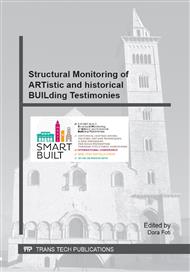[1]
B. David, Y. Chuantao, Z. Yun, X. Tao, Z. Bingxue, J. Huiliang, R. Chalon. SMART-CITY: Problematics, techniques and case studies. Proceedings of the 8th International Conference on Computing Technology and Information Management (ICCM), vol. 1 April 2012, pp.168-174.
Google Scholar
[2]
S. Djahel, M. Salehie, I. Tal, P. Jamshidi. Adaptive traffic management for secure and efficient emergency services in smart cities. Proceedings of the IEEE International Conference on Pervasive Computing and Communications Workshops (PERCOM Workshops), 18-22 March 2013, pp.340-343.
DOI: 10.1109/percomw.2013.6529511
Google Scholar
[3]
G. Horng, J. Li, S. Cheng. Traffic congestion reduce mechanism by adaptive road routing recommendation in smart city. Proceedings of the 3rd International Conference on Consumer Electronics, Communications and Networks (CECNet), 20-22 November 2013, pp.714-717.
DOI: 10.1109/cecnet.2013.6703431
Google Scholar
[4]
S. Suakanto, S. H. Supangkat, Suhardi, R. Saragih. Smart city dashboard for integrating various data of sensor networks. Proceedings of the International Conference on ICT for Smart Society (ICISS), June 2013, pp.1-5.
DOI: 10.1109/ictss.2013.6588063
Google Scholar
[5]
F. Juraschek, A. Zubow, O. Hahm, M. Scheidgen, B. Blywis, R. Sombrutzki, M. Gunes, J. Fischer. Towards Smart Berlin - an experimental facility for heterogeneous Smart City infrastructures, Proceedings of the 37th Conference on Local Computer Networks Workshops (LCN Workshops), October 2012, pp.886-892.
DOI: 10.1109/lcnw.2012.6424078
Google Scholar
[6]
S. Pellicer, G. Santa, A.L. Bleda, R. Maestre, A.J. Jara, A. Gomez Skarmeta. A Global Perspective of Smart Cities: A Survey. Proceedings of the Seventh International Conference on Innovative Mobile and Internet Services in Ubiquitous Computing (IMIS), 3-5 July (2013).
DOI: 10.1109/imis.2013.79
Google Scholar
[7]
L. Sanchez, V. Gutierrez, J.A. Galache, P. Sotres, J.R. Santana, J. Casanueva, L. Munoz. SmartSantander: Experimentation and service provision in the smart city. Proceedings of the 16th International Symposium on Wireless Personal Multimedia Communications (WPMC), June 2013, pp.1-6.
DOI: 10.1109/wons.2012.6152226
Google Scholar
[8]
Sino-Singapore Tianjin Eco-City, smart grid, smart city, Innovative Smart Grid Technologies (ISGT), 2012 IEEE PES , Jan. (2012).
DOI: 10.1109/isgt.2012.6175618
Google Scholar
[9]
P. Neirotti, A. De Marco, A. C. Cagliano, G. Mangano, F. Scorrano. Current trends in Smart City initiatives: Some stylised facts. Cities, 28 (2014) 25-36.
DOI: 10.1016/j.cities.2013.12.010
Google Scholar
[10]
A. Özerdem, G. Rufini. L'Aquila's reconstruction challenges: Has Italy learned from its previous earthquake disasters? Disasters, 37 (1) (2013), 119-143.
DOI: 10.1111/j.1467-7717.2012.01296.x
Google Scholar
[11]
G. Brandonisio, G. Lucibello, E. Mele, A. De Luca. Damage and performance evaluation of masonry churches in the 2009 L'Aquila earthquake, Engineering Failure Analysis. 34 (2013) 693-714.
DOI: 10.1016/j.engfailanal.2013.01.021
Google Scholar
[12]
S. Russo. On the monitoring of historic Anime Sante church damaged by earthquake in L'Aquila. Structural Control and Health Monitoring, 20(9) (2013) 1226-1239.
DOI: 10.1002/stc.1531
Google Scholar
[13]
C. Rainieri, G. Fabbrocino, G. Manfredi, M. Dolce. Robust output-only modal identification and monitoring of buildings in the presence of dynamic interactions for rapid post-earthquake emergency management. Engineering Structures, 34 (2012).
DOI: 10.1016/j.engstruct.2011.10.001
Google Scholar
[14]
D. Foti, V. Gattulli, F. Potenza. Output-Only identification and model updating by dynamic testing in unfavorable conditions of a seismically damaged building. Computer-Aided Civil and Infrastructure Engineering 00 (2014) 1–17.
DOI: 10.1111/mice.12071
Google Scholar
[15]
D. Spina, D. Lamonaca, B. G. Nicoletti, M. Dolce. Structural monitoring by the Italian Department of Civil Protection and the case of 2009 Abruzzo seismic sequence. Bulletin Earthquake Engineering, 9 (2011) 325–346.
DOI: 10.1007/s10518-010-9232-4
Google Scholar
[16]
F. Federici, F. Graziosi, M. Faccio, V. Gattulli, M. Lepidi, F. Potenza, A. Colarieti. An integrated approach to the design of Wireless Sensor Networks for structural health monitoring. International Journal of Distributed Sensor Networks, (2012).
DOI: 10.1155/2012/594842
Google Scholar
[17]
M.R. Gallipoli, M. Mucciarelli, M. Vona. Empirical estimate of fundamental frequencies and damping for Italian buildings. Earthquake Engineering and Structural Dynamics. 38 (2009) 973-988.
DOI: 10.1002/eqe.878
Google Scholar
[18]
M. Maugeri, A. L. Simonelli, A. Ferraro, S. Grasso, A. Penna. Recorded ground motion and site effects evaluation for the April 6, 2009 L'Aquila earthquake. Bull Earth. Eng. 9 (2011) 157–179.
DOI: 10.1007/s10518-010-9239-x
Google Scholar
[19]
E. Antonacci, A.M. Ceci, A. Colarieti, V. Gattulli, F. Graziosi, M. Lepidi, F. Potenza. Dynamic testing and health monitoring via wireless sensor networks in the post-earthquake assessment of structural condition at L'Aquila. 8th European Conference on Structural Dynamics, Eurodyn11, Leuven, Belgium, (2011).
DOI: 10.1155/2012/594842
Google Scholar
[20]
V. Gattulli. Advanced applications in the field of structural control and health monitoring after the 2009 L'Aquila earthquake. In Dr Sebastiano D'Amico (Ed. ), Engineering Seismology, Geotechnical and Structural Earthquake Engineering, InTech, Chapter 9, (2013).
DOI: 10.5772/55438
Google Scholar
[21]
G. Krishnan, C.U. Kshirsagar, N. Bhat and G.K. Ananthasuresh. Micromachined high resolution accelerometers. Journal of the Indian Institute of Science, 87(3) (2007) 333-361.
Google Scholar
[22]
USGS and ANSS National Implementation Committee. Instrumentation Guidelines for the Advanced National Seismic System, (2007).
Google Scholar
[23]
A.M. Ceci, V. Gattulli, F. Potenza. Serviceability and damage scenario in RC irregular structures: post-earthquake observations and modelling predictions. ASCE Journal of Performance of Constructed Facilities, 27(1) (2013) 98-115.
DOI: 10.1061/(asce)cf.1943-5509.0000317
Google Scholar
[24]
M. Lepidi, V. Gattulli, D. Foti. Bell-swinging resonances and their cancellation identified by dynamical testing in a modern bell tower, Engineering Structures, 31(7) (2009) 1486-1500.
DOI: 10.1016/j.engstruct.2009.02.014
Google Scholar
[25]
V. Gattulli, F. Graziosi, F. Federici, F. Potenza, A. Colarieti, M. Lepidi. Structural Health Monitoring of the Basilica S. Maria di Collemaggio Proceedings of The Fifth International Conference on Structural Engineering, Mechanics and Computation SEMC 2013, Cape Town South Africa, 2-4 September (2013).
DOI: 10.1007/s13349-015-0146-3
Google Scholar
[26]
V. Gattulli, M. Lepidi, F. Potenza. Seismic protection of frame structures via semi-active control: modelling and implementation issues. Earthquake Engineering & Engineering Vibration, 8(4) (2010) 627-645.
DOI: 10.1007/s11803-009-9113-5
Google Scholar
[27]
V. Gattulli, R. Alaggio, F. Potenza. Analytical prediction and experimental validation for longitudinal control of cable oscillations. International Journal of Non-Linear Mechanics, 43 (2008) 36-52.
DOI: 10.1016/j.ijnonlinmec.2007.10.001
Google Scholar
[28]
E. Antonacci, A. De Stefano, V. Gattulli, M. Lepidi, E. Matta. Comparative study of vibration-based parametric identification techniques for a three-dimensional frame structure, Journal of Structural Control and Health Monitoring, 19 (2012).
DOI: 10.1002/stc.449
Google Scholar



